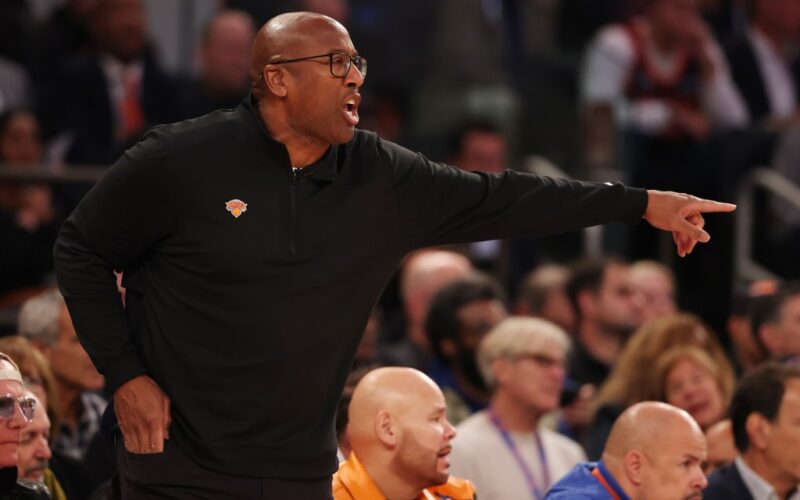There are nine minutes left in the second quarter, but this isn’t basketball. It’s Oct. 25, 2020: Seattle Seahawks vs. Arizona Cardinals. Russell Wilson, lined up in shotgun, flicks a pass toward running back Chris Carson. The ball never gets there. Budda Baker jumps the route, intercepts it, and has a clear 95-yard runway to the end zone.
This is the moment that gives Mike Brown goosebumps.
The Knicks’ new head coach showed this clip to his players during training camp. To him, it’s not a football highlight. It’s a masterclass in next-play speed.
Because what happens next defines everything he wants his Knicks to become, and through the few games of the early season, they’re already showing signs of becoming that team.
Without hesitation, Seahawks receiver DK Metcalf explodes from the two-yard line. He hits another gear, chasing Baker 90-plus yards and tackling him five shy of the goal line.
“If you watch DK Metcalf, it was ‘bam, right now.’ He went from possibly catching the ball and scoring a touchdown, interception happened, and he didn’t [shrug his shoulders], he didn’t take an extra step towards the sideline. It was right now,” Brown explains. “I’ve watched [that play] hundreds of times. It gives me goosebumps just to see somebody make that play. It doesn’t show up on the stat sheet but that was the play of the game in my opinion no matter what happened.”
This is the urgency Brown demands from the Knicks. Next-play speed is the ability to instantly flip from offense to defense, from reaction to response, from mistake to redemption. And after training camp, preseason and a few early games, his new-look Knicks are beginning to build their identity around it.
“One of my pet peeves is when we don’t have buy-in with the next-play speed,” Brown said. “So that’s something we’re tracking, constantly showing examples of it. Our guys will get it — because that’s the only way we’re gonna get where we want to go. That’s part of having that competitive spirit.”
**
There’s 1:49 left in the third quarter of the Knicks’ preseason finale against the Charlotte Hornets, and Mikal Bridges channels his inner DK Metcalf.
He drives the lane, throws a bad pass, and watches Charlotte’s Pat Connaughton get out in transition. But before the ball even crosses halfcourt, Bridges is already in sprint mode. He chases Connaughton down, forces a missed layup, then turns right around to sprint back and fill his corner lane for the next offensive possession.
If any Knick embodies Brown’s philosophy, it’s Bridges, the ironman who literally out-sprinted teammates during a free throw penalty in training camp.
“Mikal’s next-play speed is unbelievable,” Brown said. “Turnover happens or offensive rebound happens, and he doesn’t hesitate or take an extra step the wrong way. His change of direction is instant — the flip of a switch. It’s amazing. Probably one of the best I’ve been around.”
The Knicks have long had the personnel to play with this tempo: Bridges, OG Anunoby, Josh Hart, Miles McBride, all capable of wreaking havoc in the open floor. But under Tom Thibodeau, the Knicks never realized their full potential, even if they had an Eastern Conference Finals appearance to show. It’s part of why the Knicks turned the page, moving on from Thibodeau in favor of Brown and his up-tempo philosophies.
In Year 1 under their new head coach, the Knicks are finally beginning to unlock the tempo and versatility that had been hiding in plain sight.
“[Mike] emphasizes it more,” Bridges said. “He got me really just forgetting about the last play and getting back, getting the whole team on that. That’s how it’s supposed to be. He’s encouraging us every single day, putting pressure on us to do it every single time.”
**
The early numbers don’t tell the full story. The Knicks rank near the bottom of the league in both pace and fast-break points.
But Brown turns his nose at those metrics. He likes to use his own eyes and his own count.
The NBA doesn’t formally define fast-break points in its stats glossary, typically counting only possessions finished within a few seconds of the rebound or turnover. Brown’s version is more expansive. He counts sequences where the Knicks force tempo before a defense sets, even if it takes two or three passes to find the payoff.
The stat keepers of an Oct. 9 preseason game against the Minnesota Timberwolves, for example, credited the Wolves with 13 fast break points — 12 fewer than Brown and his staff counted that night.
“There are other things we look at in terms of fast-break points, which is why I said they had around 25 against us tonight because we weren’t always good at getting back with our next play speed,” Brown said after that game. “Whether we took a tough shot and now the ball is going the other way or we turned it over and the ball is going the other way, we’ve got to change like, ‘boom,’ just like that. We go from offense to defense right now.
“If we take two extra shots the opposite direction, now they’re running out on us and they have an advantage in transition. They may not score it right away, but they’ll eventually swing-swing to a wide-open shot because we didn’t play with next-play speed all the time or we took a tough shot.”
Against the Celtics, that vision came to life. The Knicks forced seven Jaylen Brown turnovers, including a sequence that summed up everything Brown preaches: Bridges pokes the ball loose, Towns recovers and leads the break, passes ahead to Hart, who feeds it right back for an and-one layup.
“We’re just doing a good job of getting back and making people play against what this locker room possesses, which is a strength for us: our length and our size,” said Towns. “We’re doing a great job of getting back in transition and making people have to play in the half-court against us. All of this is without Mitch, so we have a lot more room to grow.”
**
Brown believes when starting center Mitchell Robinson clears his left ankle load management protocol, the Knicks’ defense can reach elite territory.
“We can be a monster of a defensive team,” Brown said after New York’s win over Boston. “And when we get the ball off the glass or create a turnover with our activity, we’ve got so many weapons that can push the pace. We want to attack before that defense is set.
“We showed flashes of it tonight. Now we’ve got to string it together for a little closer to 48 minutes.”
The Knicks’ box score showed a 15-2 edge in fast-break points against the Celtics, though Brown’s unofficial tally was surely higher.
The Knicks aren’t just running faster. They’re thinking faster, reacting faster, believing faster. They’re becoming a team that plays with next-play speed.
And just like DK Metcalf’s chase-down, next-play speed might not show up on the stat sheet, but it can change everything, from a game to a season.
“We got guys that turn defense into offense [and] we finish possessions with rebounds, throw the ball ahead, play fast,” said Hart. “We got guys that can do that defensively, guys that can knock down shots, get to the rim, so I think we have all the pieces to do that. Now is just continuing to do it on a consistent basis.”








